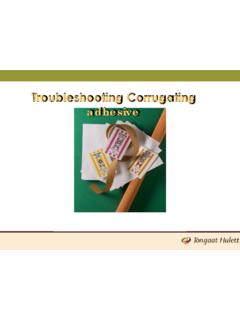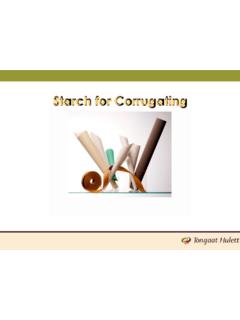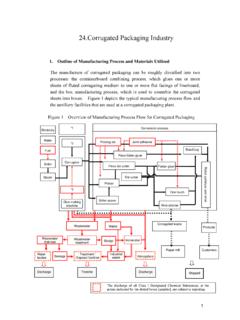Transcription of Go with the flow - HarperLove
1 FEBRUARY 2007Go with the flowBy John KohlGet a handle on starch adhesive viscosityViscosity is the measure of a liquid s resistance to flow. Stable viscosity is critical in corrugating adhesive if we expect it to deliver consistent corrugating adhesive is a liquid comprising 25% to 30% solids and 70% to 75% water. The way we make adhesive from corn starch , so it has a stable viscosity and is resistant to the loss of viscosity over time, is to completely cook out a portion of the starch . This cooked portion is referred to as the carrier starch since it keeps the raw starch in suspension for an extended period of time and carries the uncooked starch through the pipes and to the glue line for gelatinization by the heat on the corrugator. This is called the Stein Hall Method, and has been the basis for corrugating adhesive since the 1940s. The carrier portion of the adhesive is only 3% to 6% of the total adhesive but is the key to the Stein Hall process.
2 Not only does it keep the uncooked starch in suspension, it also controls the viscosity of the finished batch of adhesive. This is very evident on automatic high-shear starch mixers, where the amount of carrier is easily changed, and the resultant change in the finished batch viscosity is easily are two acceptable methods to measure the starch adhesive viscosity in a box plant: the Love Cup or the Stein Hall cup. Both cups measure the adhesive flow through an orifice over time. The Stein Hall cup (below left) should be preheated with the adhesive before the actual test is performed. It has a wall thickness of 3/16 solid brass that, if colder than the adhesive to be tested, will cool off the sample before the test is complete. This will give an inaccurate measurement. When filling the Stein Hall cup with adhesive, the adhesive should be strained through a kitchen strainer to remove any debris that could plug up the 1/10 hole the adhesive must pass through.
3 The operator will measure the time the adhesive takes to drain out of the cup, starting at the top pin in the cup, and ending at the bottom pin. The resulting measurement should be recorded as seconds Stein Stein Hall cupThe Love cupThe Love Cup (above) has a wall thickness of only 1/16 so is less likely to cool the adhesive being tested. It also has an orifice that is in diameter and is less likely to plug up with starch debris that could alter the viscosity reading. When measuring viscosity with a Love Cup, fill the cup by completely submersing the cup in the adhesive. Start the timer when the cup is lifted out of the adhesive and stop the timer when the adhesive drains low enough to expose the crossbar in the bottom of the cup. Record the viscosity results in seconds Love Cup. Since the drain orifice in the bottom of the cup is times larger than the Stein Hall cup, the readings are approximately half that of Stein Hall.
4 (Ask your Harper/Love rep for a conversion chart)Viscosity is sensitive to temperature changeWhichever cup is used to measure the viscosity of the adhesive, it is important to check the temperature of the adhesive being tested and record it along with the viscosity, , 24 seconds Love Cup @ 1040F. starch -based adhesive is very sensitive to temperature change. For every 20F change in its temperature, the adhesive viscosity measure in Stein Hall will change by 10% from the last reading. with an increase in temperature the viscosity drops and with a decrease in temperature in viscosity goes up. (next page, please)Consistency is keyThe need for consistency in starch adhesive viscosity on the corrugator cannot be overemphasized. Viscosity is as important as the glue-roll gap setting for controlling the amount of adhesive that is transferred to the flute tips. If there is too much or too little adhesive applied to the flute tips you can experience warp or loose liner and delamination.
5 All the variables mentioned, along with poor adhesive formulation, can alter the viscosity at the corrugator. The corrugator (and the board quality it produces) is only as good as the adhesive it is supplied with . This makes it important to work with your starch supplier to develop an ideal target range for the adhesive viscosity on you is no single viscosity for starch adhesive that will work for all box plants. The ideal viscosity depends on the machine, and may also be fine-tuned for different paper grades or product mixes. Whatever the viscosity target is in your plant, it needs to be monitored continuously to ensure the adhesive bond and overall board quality are the best possible. Variables that affect viscosityStarch adhesive storage tanks have a hot water circulating system, called a TVC (temperature and viscosity control) system, to keep the adhesive warm and minimize viscosity variations. The storage tank temperature can also be affected by the finished batch temperature, the returned starch from the corrugator pans, and ambient air temperature.
6 All these variables need to be taken into account to keep the adhesive viscosity in an acceptable range for the viscosity and temperature should be checked and recorded for every batch made in a manual system, and at least twice per shift on an automatic system. The adhesive at the corrugator pans (or sumps) should also be checked twice per shift to ensure the viscosity is in the ideal range for your things that can greatly affect the adhesive viscosity include: wash-up water being sent back to the storage tanks, bacteria infestation in the storage tanks, and excessive mechanical shear from the transfer and supply pumps. ( starch viscosity, continued)Ed Smith 1952-2006Ed Smith, technical representative for Harper/Love passed away December 14, was born in Omaha, Nebraska, and began his career in corrugating there with Weyerhaeuser. He was with Smurfit Stone in LaPorte, Indiana, for many years until that plant ceased operations, then worked with several plants in Indiana and Michigan before joining Harper/Love in April, lived in Rolling Prairie, Indiana, and served Harper/Love customers in Indiana, Michigan, and will be missed.
7 We extend our condolences to his family and friends. Soak-tank lessonsThe medium has a message, tooBy Bill KahnOne of the best analytical tools available in a corrugated plant is the soak tank. Its use allows us to observe a broad spectrum of machine and adhesive issues which can result in quality problems. In addition to light and heavy adhesive application, we can also discover tension issues, glue roll speed issues and numerous other often we see operators soak the corrugated sheet apart and immediately discard the medium to focus their attention on the resultant glue lines on both liners. This is a sheet of medium contains many valuable clues concerning the proper placement of the adhesive as well as the possibility of adhesive slinging (photo, left) which can be costly in terms of excess consumption as well as leading to unexplained warp problems. It can be a real eye-opener to use the iodine stain on the piece of medium and see the adhesive that has been delivered to the flank of the flutes or even to the valley of the that the adhesive is applied to the medium before it gets to the liner, so a thorough investigation should track the adhesive from the glue roll to the medium and then to the is your adhesive consumption number and why does it matter?
8 By Wayne PorellFew operational concerns have more direct impact on a facility s ability to produce high-quality corrugated board than the optimal application of a quality adhesive. The first step in optimizing adhesive application is to know the plant s adhesive consumption number. If a plant does not track and chart its consumption, or does not document the information and make it available, the facility is overlooking one of its most valuable tools for improving and warp are the most common motivations for a facility to reduce adhesive consumption. Excessive application simply wastes money; it puts dollars into the operation that yield no return. Excessive or uneven application can make it difficult to control warp at the machine and may also cause post-corrugator warp, both of which have a negative impact on converting are some more reasons to control adhesive consumption Excessive application can also lead to washboarding, which creates a poor printing surface.
9 Performance of both slitter and cut-off knives can be affected; in facilities with optimized application we see cleaner, crisper slits and cuts, improved slitter-blade life and reduced cut-off knife tuning. Often, higher speeds can be achieved simply by optimizing (reducing) adhesive application. Here s how that works: Excessive adhesive requires more BTU (energy) to gel the adhesive. Sometimes the only way to increase the amount of energy transferred to the adhesive is to slow down the machine so the adhesive is exposed to heating surfaces for longer periods of time. Reducing adhesive application eliminates the problem and allows higher speeds. Optimized adhesive application can also increase throughput in converting operations; not only is warp reduced, but the firmer, cleaner sheet is easier to cut, print, and fold. Excessive adhesive application is often the cause of white lining or loose edges at higher speeds. A common mistake, when these problems occur, is to increase the adhesive application, which can exacerbate white the many ways adhesive application affects processes and ultimately costs, it is clearly important that plant management and personnel have accurate knowledge and understanding of their consumption number.
10 In facilities that track consumption and make the information readily available, the consumption number can function as an early-warning indicator to help monitor adhesive formulation, detect maintenance issues, reveal areas where training is needed, and bring to light possible production constraints. Many plants track their consumption, adhesive viscosity, and adhesive gel temperature on parallel historical forms. In these plants, issues are often discovered and resolved before they cause serious quality or production is powerResisting temptation:reducing adhesive solids is false economyBy Rex Woodville-Price As pearl starch prices rise, it is tempting to consider reducing starch cost by decreasing the solids content of the adhesive. starch , after all, is one of the few components in a box, the quantity of which can be controlled. However appealing this idea may appear, there is much risk reasons why lowering the solids content of adhesive is not a good idea: Energy costs will increase since we now have to evaporate the additional water in the adhesive Corrugator speeds go down because the machine needs more time to evaporate the additional water Waste will go up due to diminished bond quality Warp will increase Board cost will go up due to decreased throughputStarch remains your lowest-cost box componentAlthough starch prices have increased, paper prices have also increased.










